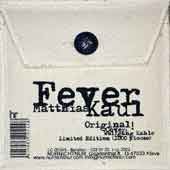
The intervallic content of the D Sharp Phrygian no 4 major 6 Scale as one would find it on any conventionally tuned, equal tempered instrument.
 Interplay: Apology to the Atonists / Tritone Suite. 2008. Porter Records: PRCD-4009.
Interplay: Apology to the Atonists / Tritone Suite. 2008. Porter Records: PRCD-4009. Mark Helias' Open Loose: Atomic Clock. 2008. Radio Legs Music: RL 012.
Mark Helias' Open Loose: Atomic Clock. 2008. Radio Legs Music: RL 012. Shonen Knife: Happy Hour. 1998. Big Deal: BD 9055.
Shonen Knife: Happy Hour. 1998. Big Deal: BD 9055. Ellery Eskelin: Premonition. 1993. Prime Source: CD 2010.
Ellery Eskelin: Premonition. 1993. Prime Source: CD 2010. Johanna Beyer: Sticky Melodies. 2008. New World Records: 80678-2.
Johanna Beyer: Sticky Melodies. 2008. New World Records: 80678-2. Thelonious Monk: The Complete Riverside Recordings [disc 1]. 1986. Riverside: RCD-022-2.
Thelonious Monk: The Complete Riverside Recordings [disc 1]. 1986. Riverside: RCD-022-2. Weasel Walter Large Ensemble and Tony Dryer/Jacob Felix Heule/Bobby Loachfillet Trio @ The Uptown, Oakland, CA
Weasel Walter Large Ensemble and Tony Dryer/Jacob Felix Heule/Bobby Loachfillet Trio @ The Uptown, Oakland, CA Marc Ducret: Un Certain Malaise. 1997. Screwgun Records: Screwu 70005.
Marc Ducret: Un Certain Malaise. 1997. Screwgun Records: Screwu 70005. Misha Mengelberg: The Root Of The Problem. 1997. Hat Hut Records: hatOLOGY 504.
Misha Mengelberg: The Root Of The Problem. 1997. Hat Hut Records: hatOLOGY 504. Louis Moholo-Moholo/Marilyn Crispell: Sibanye (We Are One). 2008. Intakt: CD 145.
Louis Moholo-Moholo/Marilyn Crispell: Sibanye (We Are One). 2008. Intakt: CD 145. sfSoundGroup: sfSoundSeries @ ODC Dance Commons, Studio B, San Francisco, CA
sfSoundGroup: sfSoundSeries @ ODC Dance Commons, Studio B, San Francisco, CA Elliott Sharp: In The Land of The Yahoos. 1987. SST Records: CD 128.
Elliott Sharp: In The Land of The Yahoos. 1987. SST Records: CD 128. Steve Reich: Music for 18 Musicians. 2007. Innova: 678.
Steve Reich: Music for 18 Musicians. 2007. Innova: 678. Albert Ayler: Holy Ghost [box set - disc 9]. 2004. Revenant: RVN 213.
Albert Ayler: Holy Ghost [box set - disc 9]. 2004. Revenant: RVN 213. Brad Jones' AKA Alias: Uncivilized Poise. 1999. Knitting Factory Records: KFR-247.
Brad Jones' AKA Alias: Uncivilized Poise. 1999. Knitting Factory Records: KFR-247. Katt Hernandez/Evan Lipson: Hisswig. 2007. Limited-run mini-disc.
Katt Hernandez/Evan Lipson: Hisswig. 2007. Limited-run mini-disc. Mazen Kerbaj: Brt Vrt Zrt Krt. 2005. Al Maslakh: 01.
Mazen Kerbaj: Brt Vrt Zrt Krt. 2005. Al Maslakh: 01. The Sun Ra Arkestra under the direction of Marshall Allen: Points On A Space Age. DVD. Directed by Ephraim Asili. 2009. MVD Visual: MVDV4774.
The Sun Ra Arkestra under the direction of Marshall Allen: Points On A Space Age. DVD. Directed by Ephraim Asili. 2009. MVD Visual: MVDV4774. Chris Mosley Trio: The Miraculous Aspect of Time. 2006. Red Button Records: RBR-101.
Chris Mosley Trio: The Miraculous Aspect of Time. 2006. Red Button Records: RBR-101. Myra Melford/Be Bread: The Image of Your Body. 2006. Cryptogramophone: CG131.
Myra Melford/Be Bread: The Image of Your Body. 2006. Cryptogramophone: CG131. Nicole Mitchell/Harrison Bankhead/Hamid Drake: Indigo Trio Live in Montreal 2005. Greenleaf Music: GRE-P-03.
Nicole Mitchell/Harrison Bankhead/Hamid Drake: Indigo Trio Live in Montreal 2005. Greenleaf Music: GRE-P-03. John Schneider: Just Guitars. 2003. Bridge Records: 9132.
John Schneider: Just Guitars. 2003. Bridge Records: 9132. Lisle Ellis: Sucker Punch Requiem: An Homage to Jean-Michel Basquiat. 2008. Henceforth Records: 104.
Lisle Ellis: Sucker Punch Requiem: An Homage to Jean-Michel Basquiat. 2008. Henceforth Records: 104. Matthias Kaul: Fever. 2002. Nurnichtnur: LC 1020120.
Matthias Kaul: Fever. 2002. Nurnichtnur: LC 1020120.